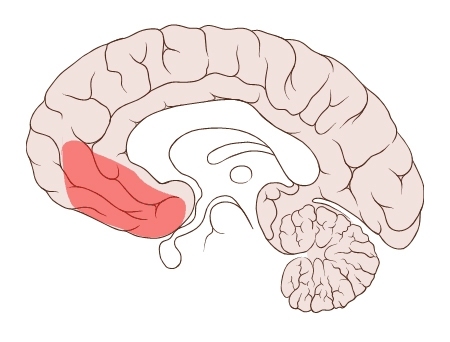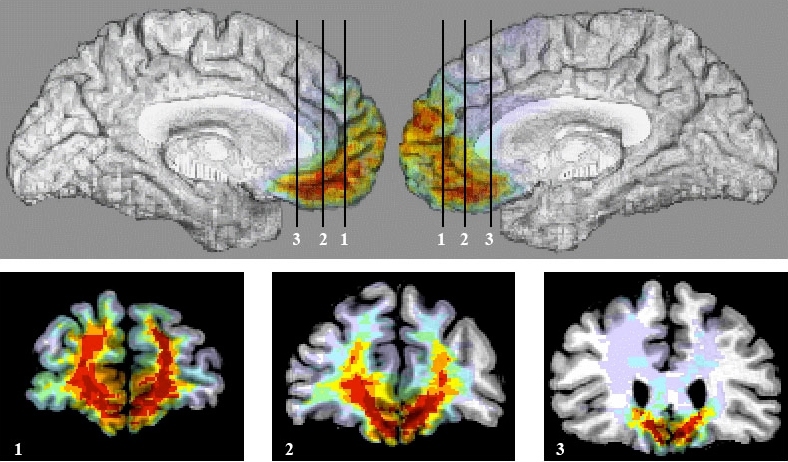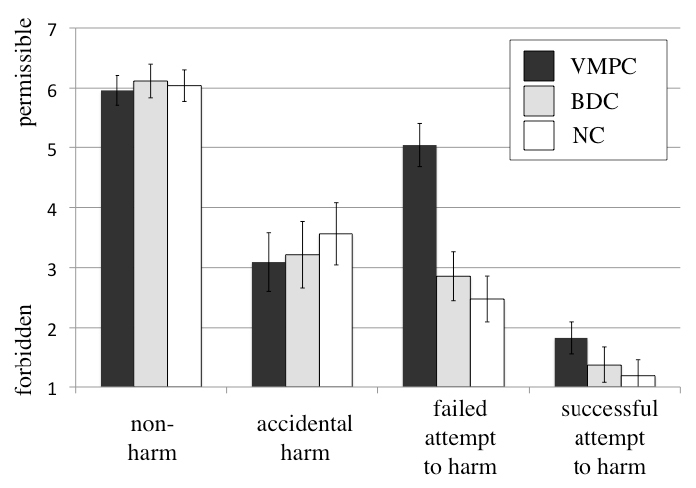Imagine this scenario: A woman and her friend are touring a chemical factory. They come to a coffee machine and, next to it, a container labeled “toxic.” The woman sees the label but goes ahead and scoops a powdery white substance from the container into a cup of coffee she has brewed for her friend. The friend drinks the coffee but is unharmed, because it turns out the powder was only sugar.
Most people would say the woman’s actions were morally repugnant. However, in a new study, patients with damage to a part of the brain known as the ventromedial prefrontal cortex (VMPC) reacted very differently. They were unable to conjure a normal emotional response to the situation, and based their judgment only on the outcome — that is, no harm was done. In their view, the friend’s actions were morally permissible.
That suggests that the human brain’s ability to respond appropriately to intended harms — that is, with outrage toward the perpetrator — is seated in the VMPC, a brain region associated with regulating emotions.
The finding offers a new piece to the puzzle of how the human brain constructs morality, says Liane Young, a postdoctoral associate in MIT’s Department of Brain and Cognitive Sciences and lead author of a paper describing the findings in the March 25 issue of the journal Neuron.
“We’re slowly chipping away at the structure of morality,” says Young. “We’re not the first to show that emotions matter for morality, but this is a more precise look at how emotions matter.”
Judging others
Working with researchers at the University of Southern California, led by Antonio Damasio, Young studied a group of nine patients with damage (caused by aneurisms or tumors) to the VMPC, a plum-sized area located above and behind the eyes.
Such patients have difficulty processing social emotions such as empathy or embarrassment, but “they have perfectly intact capacity for reasoning and other cognitive functions,” says Young.
A 2007 study by Damasio, Young and their colleagues showed that such patients are more willing than non-brain-damaged adults to judge killing or harming another person as morally permissible if doing so would save others’ lives. That led the researchers to suspect that the brain-damaged patients lacked appropriate emotional responses to moral harms and relied instead on calculating, rational approach to moral dilemmas.
In the new Neuron study, the researchers tried to tease out the exact role of emotional responses in making moral judgments. They gave the subjects a series of 24 scenarios and asked for their reactions. The scenarios of most interest to the researchers were ones featuring a mismatch between the person’s intention and the outcome — either failed attempts to harm or accidental harms.
“Every time we make a judgment, there are lots of factors that influence it, and two of the most important are what the agent wants to do, and what actually happens,” says Young.
When confronted with failed attempts to harm, the patients had no problems understanding the perpetrator’s intentions, but they failed to hold them morally responsible. The patients even judged attempted harms as more permissible than accidental harms (such as accidentally poisoning someone) — a reversal of the pattern seen in normal adults.
“They can process what people are thinking and their intentions, but they just don’t respond emotionally to that information,” says Young. “They can read about a murder attempt and judge it as morally permissible because no harm was done.”
This supports the idea that making moral judgments requires at least two processes — a logical assessment of the intention, and an emotional reaction to it, says Michael Koenigs, a neuroscientist at the University of Wisconsin who has also studied patients with VMPC damage.
“There's no doubt that our moral sense is informed by our ability to infer the intentions of others, and to generate an affective response to those intentions,” says Koenigs. “This study implicates VMPC as a key area for integrating intention with affect [emotional feeling] to yield moral judgment.”
The ability to blame others who try to cause harm, even when they fail, may have evolved as a way to protect ourselves from those with malevolent intentions, says Young. “This information is critical for making judgments about whom to be friends with and whom to trust,” she says. “We don’t want people wishing harm on us, even if they fail.”
In future work, Young hopes to study patients who incurred damage to the VMPC when they were younger, to see if they have the same impaired judgment. She also plans to study patient reactions to situations where the harmful attempts may be directed at the patient and therefore more personal.
Most people would say the woman’s actions were morally repugnant. However, in a new study, patients with damage to a part of the brain known as the ventromedial prefrontal cortex (VMPC) reacted very differently. They were unable to conjure a normal emotional response to the situation, and based their judgment only on the outcome — that is, no harm was done. In their view, the friend’s actions were morally permissible.
That suggests that the human brain’s ability to respond appropriately to intended harms — that is, with outrage toward the perpetrator — is seated in the VMPC, a brain region associated with regulating emotions.
The finding offers a new piece to the puzzle of how the human brain constructs morality, says Liane Young, a postdoctoral associate in MIT’s Department of Brain and Cognitive Sciences and lead author of a paper describing the findings in the March 25 issue of the journal Neuron.
“We’re slowly chipping away at the structure of morality,” says Young. “We’re not the first to show that emotions matter for morality, but this is a more precise look at how emotions matter.”
Judging others
Working with researchers at the University of Southern California, led by Antonio Damasio, Young studied a group of nine patients with damage (caused by aneurisms or tumors) to the VMPC, a plum-sized area located above and behind the eyes.
Such patients have difficulty processing social emotions such as empathy or embarrassment, but “they have perfectly intact capacity for reasoning and other cognitive functions,” says Young.
A 2007 study by Damasio, Young and their colleagues showed that such patients are more willing than non-brain-damaged adults to judge killing or harming another person as morally permissible if doing so would save others’ lives. That led the researchers to suspect that the brain-damaged patients lacked appropriate emotional responses to moral harms and relied instead on calculating, rational approach to moral dilemmas.
In the new Neuron study, the researchers tried to tease out the exact role of emotional responses in making moral judgments. They gave the subjects a series of 24 scenarios and asked for their reactions. The scenarios of most interest to the researchers were ones featuring a mismatch between the person’s intention and the outcome — either failed attempts to harm or accidental harms.
“Every time we make a judgment, there are lots of factors that influence it, and two of the most important are what the agent wants to do, and what actually happens,” says Young.
When confronted with failed attempts to harm, the patients had no problems understanding the perpetrator’s intentions, but they failed to hold them morally responsible. The patients even judged attempted harms as more permissible than accidental harms (such as accidentally poisoning someone) — a reversal of the pattern seen in normal adults.
“They can process what people are thinking and their intentions, but they just don’t respond emotionally to that information,” says Young. “They can read about a murder attempt and judge it as morally permissible because no harm was done.”
This supports the idea that making moral judgments requires at least two processes — a logical assessment of the intention, and an emotional reaction to it, says Michael Koenigs, a neuroscientist at the University of Wisconsin who has also studied patients with VMPC damage.
“There's no doubt that our moral sense is informed by our ability to infer the intentions of others, and to generate an affective response to those intentions,” says Koenigs. “This study implicates VMPC as a key area for integrating intention with affect [emotional feeling] to yield moral judgment.”
The ability to blame others who try to cause harm, even when they fail, may have evolved as a way to protect ourselves from those with malevolent intentions, says Young. “This information is critical for making judgments about whom to be friends with and whom to trust,” she says. “We don’t want people wishing harm on us, even if they fail.”
In future work, Young hopes to study patients who incurred damage to the VMPC when they were younger, to see if they have the same impaired judgment. She also plans to study patient reactions to situations where the harmful attempts may be directed at the patient and therefore more personal.









